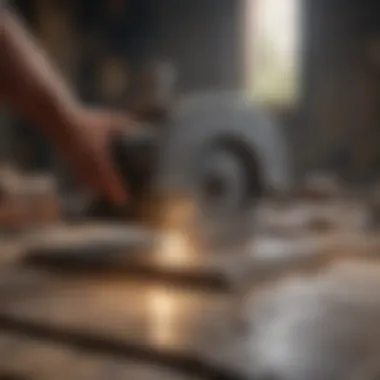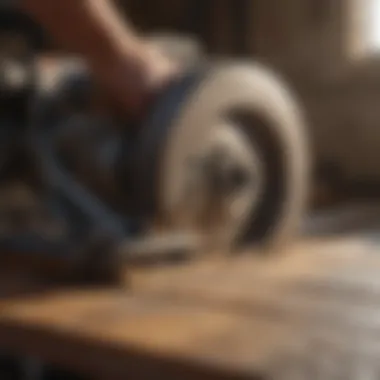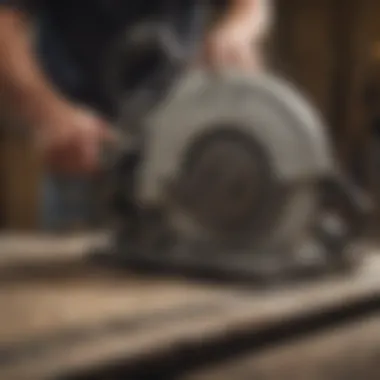Master the Craft of Efficient Tile Saw Usage for Precision Cuts


Rock and Fossil Identification
Collecting Tips and Techniques
Just as a collector carefully selects and extracts rocks and fossils, a tile saw user must handle the materials with precision and care. The best practices for collecting rocks and fossils, such as being mindful of environmental impact and adhering to legal regulations, align with the principles of safety and accuracy essential in using a tile saw. Locating prime collecting sites requires research and exploration, much like seeking out the optimal workspace and setup for efficient tile cutting. Knowing how to safely extract specimens from their natural habitat resonates with the importance of following safety protocols when operating a tile saw to prevent accidents and ensure a smooth workflow.
Preservation and Display
Once collected, rocks and fossils need preservation to maintain their integrity and value. Techniques for preserving rocks and fossils, such as cleaning and storing them properly, can be likened to the maintenance and storage practices needed for a tile saw to prolong its usability and efficiency. Proper storage methods ensure that rocks, fossils, and tile saw equipment remain in optimal condition for future use. Creative display ideas for showcasing rocks and fossils highlight the aesthetic aspect of collecting, akin to how skilled craftsmen take pride in displaying their meticulously cut tiles.
Geological Insights
Going beyond the surface level, understanding the geological formations and processes behind rocks and fossils adds depth to the collector's knowledge base. Similarly, delving into the historical significance of certain rocks and fossils parallels exploring the evolution of tools and techniques in using a tile saw. Notable discoveries in the field of geology serve as inspirational milestones for collectors and craftsmen alike, motivating them to continue honing their skills and expanding their understanding of the materials they work with.
Introduction to Tile Saws
In the vast world of tiling, a crucial tool that stands out for its utility and precision is the tile saw. This article is dedicated to unraveling the nuances of effectively utilizing a tile saw, from foundational concepts to advanced techniques. Whether you are a beginner venturing into the realm of tiling or a seasoned professional looking to refine your skills, understanding the ins and outs of a tile saw is paramount to achieving impeccable results.
Understanding the Purpose of a Tile Saw
Types of Tile Saws
When it comes to tile saws, there are various types available, each tailored to specific tiling needs. From traditional wet tile saws to portable handheld models, the diversity in types caters to different project requirements. Wet tile saws are renowned for their ability to make precise cuts, making them ideal for intricate projects that demand accuracy. On the other hand, handheld tile saws offer mobility and convenience, suitable for smaller tasks or on-site adjustments. Understanding the unique characteristics of each type enables users to select the most suitable option depending on the nature of their tiling projects.
Applications in Tiling Projects
The applications of a tile saw in tiling projects are vast and crucial for achieving flawless results. Whether it's cutting tiles for flooring, backsplashes, or intricate mosaics, a tile saw serves as a versatile ally in the tiler's toolkit. Its ability to make clean and accurate cuts not only enhances the aesthetics of the final project but also streamlines the overall tiling process. By harnessing the power of a tile saw, tilers can overcome intricate challenges with ease, ensuring that every piece fits seamlessly into the broader design puzzle, elevating the finesse and precision of their craftsmanship.
Essential Components of a Tile Saw
Blade
At the heart of every tile saw lies the blade, a fundamental component that dictates the cutting precision and efficiency of the tool. The type and quality of the blade significantly impact the outcome of tiling projects, with options ranging from continuous rim blades for delicate cuts to turbo blades for faster and rougher cuts. Choosing the right blade for the task at hand is essential to achieving smooth and accurate results, showcasing the significance of this component in the tiling process.
Motor


The motor of a tile saw is its powerhouse, driving the blade to cut through tiles with precision and speed. A robust motor ensures consistent performance, allowing users to tackle various materials effortlessly. From porcelain to natural stone, the motor's prowess influences the tool's cutting capacity, making it an indispensable component for achieving professional-grade results in tiling projects.
Water Reservoir
The presence of a water reservoir in a tile saw plays a vital role in maintaining cutting efficiency and preventing overheating. By lubricating the blade and reducing dust particles, the water reservoir not only enhances the tool's longevity but also minimizes the risk of chips and cracks on the tiles. The continuous flow of water ensures a smooth cutting experience, keeping the blade cool and the cuts precise, making it a key feature for impeccable tiling results.
Safety Precautions
Protective Gear
Protective gear is non-negotiable when operating a tile saw, safeguarding users against potential hazards and ensuring a secure working environment. Safety glasses, gloves, ear protection, and appropriate attire shield users from debris, noise, and sharp edges, promoting a safe and comfortable tiling experience. Prioritizing protective gear not only mitigates risks but also instills confidence in users, allowing them to work with peace of mind and focus on achieving professional-grade results.
Work Area Setup
The foundation of a successful tiling project lies in the setup of the work area, encompassing elements like workspace organization, proper lighting, and ventilation. A well-organized work area facilitates smooth workflow, enhances visibility during cutting operations, and promotes efficient material handling. By creating a dedicated and ergonomically sound work environment, tilers can optimize their productivity and precision, setting the stage for impeccable tile cutting outcomes.
Basic Techniques for Tile Saw Use
In the realm of using a tile saw, mastering the basic techniques is fundamental to achieving precision and efficiency. The significance of basic techniques in tile saw operation cannot be overstated. These techniques form the foundation upon which all tile cutting projects are built, ensuring accuracy and smooth execution. By understanding and applying these techniques effectively, both novices and seasoned professionals can elevate their tiling projects to a professional level.
Preparing the Tile and Saw
Tile Marking
Tile marking plays a pivotal role in the preparation phase of using a tile saw. It involves precisely measuring and marking the tile to indicate where the cut will be made. This step is crucial as it dictates the accuracy and alignment of the cut. The key characteristic of tile marking lies in its ability to serve as a guide for the saw, ensuring that the cut is executed in the desired location. Tile marking is a popular choice in the tile cutting process due to its simplicity yet effectiveness in enhancing cutting precision. While its advantages include aiding in measuring accuracy and reducing errors, a potential disadvantage could be the time required to mark each tile individually.
Blade Adjustment
Blade adjustment is another critical aspect when preparing the tile saw for cutting. Properly adjusting the blade depth ensures that the cut is neither too shallow nor too deep, resulting in a clean and precise cut. The key characteristic of blade adjustment is its role in controlling the depth of the cut, ultimately influencing the final outcome of the tile piece. This adjustment is a beneficial choice as it allows for customization based on the thickness of the tile being cut. Its unique feature lies in its ability to adapt to different tile materials and thicknesses, providing flexibility in cutting various types of tiles. While its advantages include increased cutting accuracy and reduced chipping, a disadvantage could be the need for frequent adjustments when working with different tile materials.
Cutting Straight Lines
Guided Cutting
Guided cutting simplifies the process of cutting straight lines with a tile saw. It involves using guides or attachments on the saw to ensure a straight and consistent cut across the tile surface. The key characteristic of guided cutting is its ability to maintain blade alignment and prevent deviations during the cutting process. This method is a preferred choice in tiling projects due to its precision and ease of use. Its unique feature lies in its assistance in achieving professional-grade straight cuts, essential for seamless tile installations. While its advantages include minimal chances of error and efficient workflow, a potential disadvantage could be the limitation in cutting intricate patterns or designs.
Using Fence Guides


Fence guides are essential accessories that aid in cutting straight lines with a tile saw. These guides help maintain the alignment of the tile during cutting, ensuring a consistent and accurate result. The key characteristic of using fence guides is their role in providing stability and support to the tile, reducing the likelihood of misalignment or wobbling. This technique is a popular choice in tiling projects for its ability to improve cutting precision and maintain uniformity in tile pieces. The unique feature of fence guides is their adjustability to accommodate different tile sizes and shapes, enhancing versatility in cutting applications. While their advantages include increased cutting accuracy and ease of use, a possible disadvantage could be the additional setup time required to attach and align the guides before cutting.
Cutting Curves and Angles
Freehand Techniques
When faced with cutting curved or angular lines, freehand techniques offer a flexible approach with a tile saw. This method involves manually guiding the saw blade along the desired cutting path, allowing for artistic freedom in shaping the tile. The key characteristic of freehand techniques is their versatility in creating custom cuts and intricate designs without the constraints of fixed guides. This technique is a beneficial choice for projects requiring unique tile shapes or artistic detailing. Its unique feature lies in its ability to cater to creative tile cutting while maintaining cutting accuracy. While its advantages include artistic freedom and customization options, a potential disadvantage could be the skill and precision required to achieve consistent results.
Rotating the Tile
Rotating the tile during cutting is a technique employed to achieve curved or angled cuts with a tile saw. By adjusting the tile's position while cutting, various angles and curves can be effortlessly created. The key characteristic of rotating the tile lies in its capability to produce non-linear cuts and complex shapes with ease. This method is a popular choice for projects that demand intricate tile designs or curved edges. Its unique feature is the ability to smoothly transition between different cutting angles, allowing for seamless adjustments mid-cut. While its advantages include versatility in design options and seamless curve cutting, a potential disadvantage could be the need for advanced skill and experience to master precise rotations.
Advanced Tips and Tricks
Precision Cutting Methods
Miter Cuts:
Miter cuts are a key element in achieving seamless corner joints and intricate angles in tile installations. The precision and accuracy offered by miter cuts are unparalleled, making them a go-to choice for achieving clean and polished finishes in tiling projects. The unique feature of miter cuts lies in their ability to create precise angled cuts, ensuring seamless transitions between adjacent tiles. While miter cuts require advanced skill and precision, their flawless results make them an indispensable technique in the arsenal of tile saw users.
Bevel Cuts:
Bevel cuts introduce a stylish edge profile to tiles, adding sophistication and depth to tile installations. The key characteristic of bevel cuts is their ability to create angled edges on tiles, enhancing their visual appeal and creating stunning design elements. Bevel cuts are a popular choice for creating custom edges and transitions in tile layouts, offering versatility and creativity in tile saw usage. While bevel cuts may require additional skill and attention to detail, their ability to transform tile surfaces makes them a valuable technique in achieving unique and visually striking tile designs.
Handling Specialty Tiles
Porcelain:
When it comes to handling specialty tiles such as porcelain, attention to detail is paramount for a successful tile cutting experience. Porcelain tiles are renowned for their durability and aesthetic appeal, making them a popular choice for upscale tiling projects. The key characteristic of porcelain tiles is their hardness and density, requiring specialized cutting techniques for precision and clean cuts. While working with porcelain tiles may pose challenges due to their rigidity, the unique feature of porcelain lies in its exquisite finish and resilience, making it a sought-after material for high-end tiling applications.
Glass:
Glass tiles bring a touch of elegance and modernity to tile designs, making them a coveted choice for contemporary interiors. The key characteristic of glass tiles is their translucency and reflective properties, adding depth and luminosity to tiling installations. While handling glass tiles requires delicacy and finesse, their unique feature lies in their ability to create luminous surfaces that brighten up living spaces. Despite the fragility of glass tiles, their visual impact and versatility make them a desirable option for creating sleek and sophisticated tile designs.
Maintenance and Blade Care
Cleaning the Saw:


Proper maintenance and cleaning of the tile saw are essential for ensuring optimal performance and longevity of the tool. Regularly cleaning the saw helps prevent debris buildup and ensures smooth operation during cutting tasks. The key characteristic of cleaning the saw is the maintenance of its components, including the blade and water system, to prevent clogging and corrosion. While cleaning the saw may seem like a mundane task, its unique feature lies in extending the lifespan of the tool and maintaining its cutting precision over time.
Replacing Blades:
Replacing blades is a crucial aspect of blade care and maintenance in tile saw usage. Over time, blades wear out and become less efficient, leading to dull cuts and decreased cutting power. The key characteristic of replacing blades is to ensure consistent and sharp cutting performance, allowing for smooth and accurate cuts in tile materials. While replacing blades may require some technical know-how, its unique feature lies in rejuvenating the cutting capabilities of the saw, enhancing efficiency, and producing high-quality results in tiling projects.
Troubleshooting Common Issues
In the realm of utilizing a tile saw like a seasoned professional, troubleshooting common issues is of paramount importance. Addressing and rectifying these issues not only ensure a smooth tiling process but also contribute significantly to the overall quality of the finished product. By understanding and efficiently tackling these common challenges, enthusiasts and professionals alike can elevate their tile cutting experience to new heights.
Blade Issues
Dull Blades
Delving into the realm of blade issues, the menace of dull blades presents a significant challenge in achieving precise and efficient cuts. Dull blades, characterized by a lack of sharpness and cutting prowess, can hinder the smooth operation of a tile saw. Despite their commonality, the unique feature of dull blades lies in their ability to be sharpened or replaced, offering a cost-effective option for continuous use. While beneficial in terms of affordability, dull blades may compromise the precision of cuts and prolong the tiling process, making them a rather contentious choice in this context.
Wobbling
Another pressing issue in the domain of tile saw operation is the phenomenon of wobbling blades. Wobbling blades, marked by instability and inconsistent rotation, can lead to irregular cuts and jeopardize the accuracy of tiling projects. The key characteristic of wobbling blades lies in their potential to cause damage not only to the material being cut but also to the saw itself. Despite their prevalence, the disadvantages of wobbling blades far outweigh any advantages, emphasizing the importance of addressing and resolving this issue promptly.
Water System Problems
When it comes to the efficient functioning of a tile saw, troubleshooting water system problems is crucial for maintaining optimal performance. Two common issues that frequently arise are low water pressure and leaks, each posing unique challenges that can disrupt the cutting process if left unattended.
Low Water Pressure
Among the water system problems, low water pressure stands out as a significant hindrance to the smooth operation of a tile saw. Characterized by inadequate water flow to the cutting area, low water pressure can result in overheating of the blade, leading to subpar cuts and potential damage to the saw components. While low water pressure may seem like a minor inconvenience, its impact on the overall efficiency and precision of the cutting process is substantial, making it a critical consideration in optimizing tile saw usage.
Leaks
Similarly, leaks in the water system can pose a notable challenge in maintaining the integrity of the cutting process. Whether stemming from hose connections or reservoir issues, leaks can lead to water wastage, reduced cutting efficiency, and even safety hazards in the work area. The unique feature of leaks lies in their potential to escalate into more severe water system malfunctions if not addressed promptly. Despite being a common issue, the disadvantages of leaks far outweigh any perceived benefits, underscoring the importance of vigilant monitoring and timely intervention.
User Errors
Beyond technical malfunctions, user errors represent a significant aspect of troubleshooting common issues in tile saw operation. Recognizing and rectifying these errors are imperative for ensuring not only the safety of the operator but also the quality and precision of the cuts being made.
Improper Technique
One prevalent user error that frequently plagues tiling projects is the utilization of improper cutting techniques. Improper technique, characterized by inefficient or unsafe cutting practices, can lead to substandard cuts, material wastage, and potential risks to the operator. Despite its inadvertent popularity, the unique feature of improper technique lies in its potential to be corrected through proper training and guidance, thereby enhancing the overall efficiency and effectiveness of tile saw use.
Inaccurate Measuring
Inaccurate measuring stands as another detrimental user error that can impact the success of tiling projects. Marked by imprecise measurements and inaccurate markings on tiles, this error can result in misaligned cuts, wasted material, and discrepancies in the final tile layout. The key characteristic of inaccurate measuring lies in its potential to disrupt the entire tiling process, leading to delays and rework. While a common pitfall, the disadvantages of inaccurate measuring underscore the importance of meticulous planning and execution to achieve optimal results in tile cutting projects.







